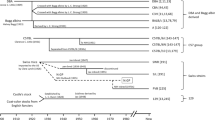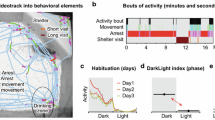Abstract
In order to determine in how far some known genes will affect the behaviour of mice (Mus musculus L.) the author used the ethological method for drawing up an inventory of behavioral elements; this can be considered the phenotype to be investigated.
For this purpose the behaviour was broken down into those elements presented by a solitary male (situation I), by two males placed together (situation II), and by one male and one female together (situation III). The environmental factors for the mice were kepts as uniform as was possible. In the present article an outline is given of the methods used in analysing that behaviour; in a later article it will be shown to what ends these methods can be used.
Similar content being viewed by others
References
Armstrong, E. A. (1950). The nature and function of displacement activities. Symp. S.E.B.IV. Cambridge, Univ. Press.
Banks, E. M. (1959). Time and motion study of prefihhting behavior in mice.Anat. Rec. 134: 532 (abstract).
Barnett, S. A. (1958). Exploratory behaviour.Brit. J. Psych. 49: 289–310.
Bastock, M., D. Morris &M. Moynhan (1953). Some comments on conflict and thwarting in animals.Behaviour 6: 66–84.
Bauer, F. J. (1956). Genetic and experiential factors affecting social reactions in male mice.J. comp. physiol. Psych. 49: 359–364.
Beeman, E. A. &W. C. Allee (1945). Some effects of thiamin on the winning of social contacts in mice.Physiol. Zool. 18: 195–221.
Bevan, J. M., W. Bevan &B. F. Williams (1958). Spontaneous aggressiveness in young castrate C3H male mice treated with three dose levels of testosterone.Physiol. Zool. 31: 284–288.
Broadhurst, P. L. (1961). analysis of maternal effects in the inheritance of behaviour.Anim. Behav. 9: 129–141.
Bruell, J. H. (1962). Dominance and segregation in the inheritance of quantitative behavior in mice. In:E. L. Bliss, Roots of Behavior. New York, Harper and Brothers.
Calhoun, J. B. (1956). A comparative study of the social behavior of two inbred strains of house mice.Eco. Monogr. 26: 81–103.
Dieterlen, F. (1962). Geburt und Geburtshilfe bei der Stachelmaus (Acomys cahirinus).Z. f. Tierpsych. 19: 191–222.
Eibl-Eibesfeldt, I. (1958). Das Verhalten der Nagetiere. In: Handbuch Zool. Bd. 8, Lief. 12, Berlin, W. de Gruyter & Co.
Eibl-Eibesfeldt, I. (1962). Technik der vergleichende Verhaltensforschung. In: Handb. Zool. Bd. 8, Lief. 31. Berlin, W. de Gruyter & Co.
Eisenberg, J. F. (1962). Studies on the behavior ofPeromyscus maniculatus gambelii andPeromyscus californicus parasiticus, Behaviour 19: 177–207.
Fuller, J. L. &W. R. Thompson (1960). Behavior Genetics. New York, Wiley.
Geer, B. W. &M. M. Green (1962). Genotype, phenotype and mating behavior ofDrosophila melanogaster.Amer. Naturalist 96: 175–181.
Hagemann, E. &G. Schmidt (1960). Ratte und Maus. W. de Gruyter & Co, Berlin.
Hirsch, J. (1962). Individual differences in behavior and their genetic basis. In:E. L. Bliss, Roots of behavior. New York, Harper and Brothers.
Lindzey, G., H. Winston &M. Manosevitz (1961). Social dominance in inbred mouse strains.Nature 191: 474–476.
Lipkow, J. (1960). Die Begattung bei der weissen Maus.Z. f. Tierpsych. 17: 182–187.
McClearn, G. E. (1959). The genetics of mouse behavior in novel situations.J. comp. physiol. Psych. 52: 62–67.
McClearn, G. E. (1961). Genotype and mouse activity.J. comp. physiol. Psych. 54: 674–676.
McGill, T. E. (1962). Sexual behaviour in three inbred strains of mice.Behaviour 19: 341–350.
Morris, D. (1956). The function and causation of courtship ceremonies. Fond. Singer-Polignac, Paris, Masson et Cie.
Rosen, J. (1961). Timidity and aggressive behavior of the rat.J. Hered. 52: 219–220.
Thiessen, D. D. (1961). Mouse exploratory behavior and body weight.Psych. Rec. 11: 299–304.
Tinbergen, N. (1940). Die Übersprungbewegung.Z. f. Tierpsych. 4: 1–40.
Whalen, R. E. (1961). Strain differences in sexual behavior of the male rat.Behaviour 18: 199–204.
Williams, E. &J. P. Scott (1954). The development of social behavior patterns in the mouse in relation to natural periods.Behaviour 6: 35–65.
Williams, C. D., S. A. Zerof &R. M. Carr (1962). Exploratory behavior of the crosses of three strains of rats.J. comp. physiol. Psych. 55: 121–122.
Author information
Authors and Affiliations
Additional information
I am indebted to ProfessorS. J. Geerts, Nijmegen, for suggesting the problem and reading the manuscript.
Rights and permissions
About this article
Cite this article
van Abeelen, J.H.F. Mouse mutants studied by means of ethological methods. Genetica 34, 79–94 (1964). https://doi.org/10.1007/BF01664181
Received:
Issue Date:
DOI: https://doi.org/10.1007/BF01664181




